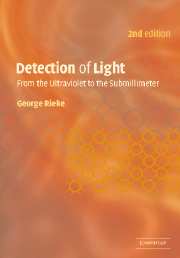Book contents
- Frontmatter
- Contents
- Preface
- 1 Introduction
- 2 Intrinsic photoconductors
- 3 Extrinsic photoconductors
- 4 Photodiodes and other junction-based detectors
- 5 Amplifiers and readouts
- 6 Arrays
- 7 Photoemissive detectors
- 8 Photography
- 9 Bolometers and other thermal detectors
- 10 Visible and infrared coherent receivers
- 11 Submillimeter- and millimeter-wave heterodyne receivers
- 12 Summary
- Appendices
- References
- Index
2 - Intrinsic photoconductors
Published online by Cambridge University Press: 09 November 2009
- Frontmatter
- Contents
- Preface
- 1 Introduction
- 2 Intrinsic photoconductors
- 3 Extrinsic photoconductors
- 4 Photodiodes and other junction-based detectors
- 5 Amplifiers and readouts
- 6 Arrays
- 7 Photoemissive detectors
- 8 Photography
- 9 Bolometers and other thermal detectors
- 10 Visible and infrared coherent receivers
- 11 Submillimeter- and millimeter-wave heterodyne receivers
- 12 Summary
- Appendices
- References
- Index
Summary
Intrinsic photoconductors are the most basic kind of electronic detector. They function by absorbing a photon whose energy is greater than that of the bandgap energy of the semiconductor material. The energy of the photon breaks a bond and lifts an electron into the conduction band, creating an electron/hole pair that can migrate through the material and conduct a measurable electric current. Detectors operating on this principle can be made in large arrays, and they have good uniformity and quantum efficiency. They are the basic component of CCDs (charge coupled devices), which are widely used two-dimensional, low light level, electronic detectors in the visible and very near infrared, also used to detect X-ray and ultraviolet photons. Photoconductors made of semiconductor compounds with small bandgaps are also useful as high-speed detectors over the 1–25 μm range.
These devices also illustrate in a general way the operation of all electronic photodetectors. All such detectors have a region with few free charge carriers and hence high resistance; an electric field is maintained across this region. Photons are absorbed in semiconductor material and produce free charge carriers, which are driven across the high-resistance region by the field. Detection occurs by sensing the resulting current.
- Type
- Chapter
- Information
- Detection of LightFrom the Ultraviolet to the Submillimeter, pp. 31 - 56Publisher: Cambridge University PressPrint publication year: 2002



